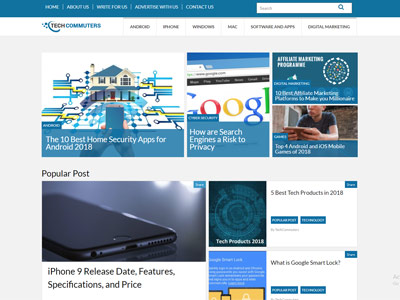Why the Best tech blog is Your Go-To Source for Expert Reviews and Insights
Why the Best tech blog is Your Go-To Source for Expert Reviews and Insights
Blog Article
Understanding the Surge of Edge Computing in Today's Digital World
In the rapidly evolving landscape of innovation, edge computer emerges as a pivotal pressure, improving exactly how information is processed and used. By transitioning information monitoring closer to the resource, edge computer addresses essential latency problems while maximizing transmission capacity usage and enhancing security procedures.
What Is Edge Computing
Side computer, although a relatively recent innovation in the realm of modern technology, fundamentally transforms how data is refined and handled by bringing computation and information storage space closer to the place where it is required. Unlike conventional cloud computer designs, which frequently rely upon central information facilities that can be geographically far-off, edge computer decentralizes data handling. This distance lowers latency, enhances real-time data handling, and boosts the overall individual experience by making sure much faster reaction times.
At its core, edge computer involves a network of local gadgets and framework, such as portals, routers, and sensors, with the ability of refining information at or near the resource. This local processing capability is especially important for applications calling for prompt information evaluation, such as self-governing lorries, commercial automation, and smart cities. Additionally, by offloading data processing tasks from central servers, edge computing decreases data transfer needs and enhances information privacy and protection, as delicate info can stay on-site as opposed to passing through substantial networks.

Trick Chauffeurs of Fostering
A number of aspects are propelling the adoption of edge computer in today's electronic landscape. Side calculating addresses this need by enabling information handling closer to the information source, reducing latency and improving real-time decision-making capacities.
An additional substantial chauffeur is the need for boosted data transfer efficiency. Centralized cloud systems can come to be overloaded with the large quantity of information created by IoT tools, bring about traffic jams (Best tech blog). By refining information at the edge, organizations can relieve network blockage and boost total system performance
Moreover, safety and personal privacy worries are pushing organizations towards side computing. By processing sensitive information in your area, firms can minimize threats connected with data transmission and exposure to potential cyber threats.
The rise of applications calling for real-time handling, such as self-governing cars and enhanced fact, also necessitates the fast reaction times that edge calculating offers. Collectively, these vehicle drivers are making side calculating a crucial part of contemporary IT infrastructure, paving the method for its widespread fostering throughout various industries.
Advantages Over Cloud Computer
How does side computing distinguish itself from standard cloud computer? Mainly, side computer brings data handling closer to the resource of information generation, commonly on neighboring servers or regional devices, rather than depending on centralized information.
Furthermore, side computer boosts data transfer performance (Best tech blog). By refining information in your area, just the necessary data is transmitted to the cloud for additional analysis or storage, minimizing the quantity of data that passes through the network. This not only reduces network blockage yet additionally decreases data transmission costs
Side computing also provides enhanced data privacy and safety. Delicate information can be processed locally without being sent to the cloud, minimizing the exposure to possible cyber risks. This is especially advantageous for sectors managing personal information, such as healthcare and monetary services.
In addition, edge computing makes certain higher resilience and integrity. Regional handling permits proceeded operation also when connectivity to the cloud is compromised, keeping vital features and services regardless of possible network disturbances. These advantages collectively demonstrate edge computer's transformative capacity in maximizing performance and safety and security in digital environments.
Challenges and Factors To Consider
While side computer offers various advantages, it likewise offers unique challenges and factors to consider that must be dealt with to totally realize its potential. Furthermore, handling and keeping track of a decentralized network of edge devices can be complex, requiring innovative devices and approaches to make certain smooth procedure and upkeep. Best tech blog.
One more consideration is the scalability of edge computing solutions. As the number of connected special info gadgets grows, so does the demand for processing power at the edge, which can result in resource constraints. Organizations must very carefully intend their infrastructure to accommodate this growth without jeopardizing efficiency or performance.
Interoperability is an additional vital aspect. With numerous equipment and software program parts entailed, ensuring compatibility and smooth assimilation can be difficult. Standardization initiatives are necessary to help with interaction in between disparate systems.
Future Trends in Side Computing
Preparing for the future, side computing is positioned to reinvent various sectors by allowing faster information processing and decreasing latency. As the volume of information generated by IoT devices continues to expand, side computer will come to be progressively crucial in handling this influx successfully. One considerable fad is the combination of artificial knowledge at the side, enabling real-time analytics and decision-making without depending on cloud-based resources. This change is anticipated to improve applications in independent cars, clever cities, and health care, where prompt data processing is crucial.
One more emerging trend is the advancement of edge-native applications made specifically to take advantage of the special capacities of side computing. These applications will optimize performance and resource use, bring about raised efficiency across various industries. Additionally, innovations in 5G modern technology will certainly further bolster edge computing by offering the needed framework for high-speed, low-latency communication in between gadgets and side nodes.
Verdict
Side computer's increase is driven by the proliferation of IoT devices and the need for real-time information handling, which improves efficiency by decreasing latency and decentralizing information management. This approach mitigates bandwidth inadequacies and security concerns, helping with developments in applications like autonomous vehicles and clever cities. Despite difficulties such as framework intricacy and combination, the future of side computer promises an extra responsive electronic environment, with continued innovations forming its evolution and increasing its applicability throughout industries.
Side computing, although a reasonably current development in the world of modern technology, essentially transforms exactly how data is refined and taken care of by bringing calculation and information storage closer to the location where it is required. Unlike traditional cloud computing versions, which commonly rely on central information centers that can be geographically remote, edge computing decentralizes information handling. Additionally, by offloading information processing jobs from main web servers, edge computing lowers data transfer requirements and boosts data personal privacy and safety and security, as delicate details can remain on-site instead than passing through considerable networks.

Report this page